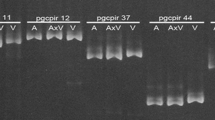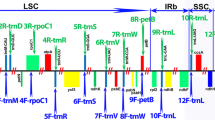Abstract
Solanum acaule Bitter is a wild, disomic tetraploid potato species widely distributed in the South America. In this study, species relationships between eight accessions ofS. acaule and 108 accessions of 27 morphologically closely related species were investigated using chloroplast and nuclear DNA RFLPs. Chloroplast DNA types were determined for most of the accessions based on restriction digestion patterns of entire chloroplast DNA. C type chloroplast DNA was common inS. acaule andS. albicans (a hexaploid derivative fromS. acaule), which was also found inS. megistacrolobum, S. sanctae-rosae,S. raphanifolium, and several other Peruvian species in seriesTuberosa. Nuclear DNA was analyzed by Southern hybridization with 31 single-copy RFLP probes. One hundred and thirty-four bands were scored, from which a UPGMA dendrogram was constructed to show overall similarities among accessions.Solanum acaule andS. albicans (andS. demissum) formed a cluster with a high similarity, and then, this group was clustered withS. megistacrolobum andS. sanctae-rosae. The resulting cluster was well separated from other clusters. Thus, we suggest that an initial tetrasomic tetraploid arose from eitherS. megistacrolobum orS. sanctae-rosae. Interestingly, a Mexican hexaploid speciesS. demissum showed the closest similarity toS. acaule andS. albicans, suggesting that they shared a common ancestry.
Resumen
La papaSolanum acaule amarga es una especie silvestre tetraploide disómica ampliamente distribuida en América del Sur. En este estudio se investigó el parentesco entre 8 accesiones de S.acaule y 108 accesiones de 27 especies emparentadas morfológicamente de forma cercana, para lo cual se usó el procedimiento de RFLP (polimorfismo en la longitud de los fragmentos de restricción) del ADN del cloroplasto y del núcleo. Los tipos de ADN del cloroplasto fueron determinados por el mayor número de accesiones basadas en los patrones de restricción de la digestión del ADN total del cloroplasto. El tipo C de cloroplasto fue común enS. Acaule yS. albicans (un hexaploide derivado deS. Acaule) el cual también fue encontrado enS. megistacrolobum, S. sanctae-rosae, S. raphanifolium y en muchas otras especies peruanas de la serieTuberosa. El ADN del núcleo fue analizado por hibridación del Sur con 31 pruebas de RFLP en copias individuales. Se contabilizaron ciento treinta y cuatro bandas, con las cuales se construyó un dendograma UPGMA para mostrar todas las similitudes entre accesiones.Solanum acaule yS. albicans (y tambiénS. demissum) formaron un grupo con una alta similitud y, por consiguiente, fueron agrupados con accesiones deS. megistacrolobum y S. sanctae-rosae. El grupo resultante fue bien separado de otros. Por lo tanto, sugerimos que se produjo un tetraploide tetrasómico inicial ya sea deS. megistacrolobum o deS. sanctae-rosae. De manera interesante, una especie hexaploide mexicana,S. demissun, mostró la muy cercana similitud conS. acaule yS. albicans, lo cual sugiere que comparten un ancestro común.
Similar content being viewed by others
Literature Cited
Bamberg, J.B., M.W. Martin, J.J. Schartner, and D.M. Spooner 1996. Inventory of tuber-bearingSolanum species. Sturgeon Bay, Wisconsin, Potato Introduction Station, NRSP-6.
Brücher, H. 1959. Kritische Bertrachtungen zur Nomenklatur argentinischer Wildkartoffeln. V. Die SerieAcaulia. Der Züchter 29:149–156.
Bukasov, S.M. 1970. Cytogenetic basis of the evolution of potato species of the genusSolanum L., sectionTuberarium (Dun.) Buk. Genetika 6:84–95.
Camadro, E.L., R.W. Masuelli, and M.C. Cortés 1992. Haploids of the wild tetraploid potatoSolanum acaule ssp.acaule: generation, meiotic behavior, and electrophoretic pattern for the aspartate aminotransferase system. Genome 35:431–435.
Castillo, R.O., and D.M. Spooner 1997. Phylogenetic relationships of wild potatoes,Solanum seriesConicibaccata (sect.Petota). Syst Bot 22:45–83.
Correll, D.S. 1962. The potato and its wild relatives. Contr Texas Res Found Bot Stud 4:1–606.
Debener, T., F. Salamini, and C. Gebhardt 1990. Phylogeny of wild and cultivatedSolanum species based on nuclear restriction fragment length polymorphisms (RFLPs). Theor Appl Genet 79:360–368.
Dvorák, J. 1983. Evidence for genetic suppression of heterogenetic chromosome pairing in polyploid species ofSolanum, sect.Pelota. Can J Genet Cytol 25:530–539.
Giannattasio, R.B., and D.M. Spooner 1994. A reexamination of species boundaries and hypotheses of hybridization concerningSolanum megistacrolobum andS. toralapanum (Solanum sect.Petota, seriesMegistacroloba): molecular data. Syst Bot 19:106–115.
Hawkes, J.G. 1990. The Potato—Evolution, Biodiversity and Genetic Resources. Belhaven Press, London.
Hawkes, J.G., and J.P. Hjerting 1969. The Potatoes of Argentina, Brazil, Paraguay, and Uruguay. Oxford University Press, London.
Hawkes, J.G., and J.P. Hjerting 1989. The potatoes of Bolivia; their breeding value and evolutionary relationships. Oxford University Press, New York.
Hosaka, K. 1986. Who is the mother of the potato? - restriction endonuclease analysis of chloroplast DNA of cultivated potatoes. Theor Appl Genet 72:606–618.
Hosaka, K. 1999. A genetic mapof Solanum phureja clone 1.22 constructed using RFLP and RAPD markers. Am J Potato Res 75:97–102.
Hosaka, K., and R.E. Hanneman, Jr. 1987. A rapid and simple method for determination of potato chloroplast DNA type. Am Potato J 64:345–353.
Hosaka, K., and R.E. Hanneman, Jr. 1988. Origin of chloroplast DNA diversity in the Andean potatoes. Theor Appl Genet 76:333–340.
Hosaka, K., and R.E. Hanneman, Jr. 1998. Genetics of self-compatibility in a self-incompatible wild diploid potato speciesSolanum chacoense. 2. Localization of an S locus inhibitor (Sli) gene on the potato genome using DNA markers. Euphytica 103:265–271.
Hosaka, K., Y. Ogihara, M. Matsubayashi, and K. Tsunewaki 1984. Phylogenetic relationship between the tuberousSolanum species as revealed by restriction endonuclease analysis of chloroplast DNA. Jpn J Genet 59:349–369.
Hosaka, K., and D.M. Spooner 1992. RFLP analysis of the wild potato species,Solanum acaule Bitter(Solanum sect.Petota). Theor Appl Genet 84:851–858.
Irikura, Y. 1976. Cytogenetic studies on the haploid plants of tuber-bearingSolanum species. 2. Cytological investigations on haploid plants and interspecific hybrids by utilizing haploidy. Res Bull Hokkaido Natl Agric Exp Stn 115:1–80.
Johnston, S.A., and R.E. Hanneman, Jr. 1980. Support of the Endosperm Balance Number hypothesis utilizing some tuber-bearingSolanum species. Am Potato J 57:7–14.
Kardolus, J.P. 1999. Morphological variation within seriesAcaulia Juz. (Solanum sect.Petota).In: Solanaceae IV (eds.: M. Nee, D.E. Symon, R.N. Lester and J.P. Jessop), pp. 257–274. Royal Botanic Gardens, Kew.
Kardolus, J.P., and N. Groendijk-Wilders 1998. The inflorescence architectureof Solanum acaule and related taxa ofSolanum sectionPetota (Solanaceae). Acta Bot Neerl 47:195–207.
Kardolus, J.P., H.J. van Eck, and R.G. van den Berg 1998. The potential of AFLPs in biosystematics: a first application inSolanum taxonomy (Solanaceae). Pl Syst Evol. 210:87–103.
Lamm, R. 1945. Cytogenetic studies inSolanum, sect.Tuberarium. Hereditas 31:1–128.
MacKey, J. 1970. Significance of mating systems for chromosome and gametes in polyploids. Hereditas 66:165–176.
Matsubayashi, M. 1982. Species differentiation inSolanum, sect.Petota. 11. Genomic relationships betweenS. acaule and certain diploidCommersoniana species. Sci Rept Fac Agr Kobe Univ 15:23–33.
Matsubayashi, M. 1991. Phylogenetic relationships in the potato and its related species.In: Chromosome Engineering in Plants: Genetics, Breeding, Evolution, Part B (eds.: T. Tsuchiya and P.K. Gupta), pp. 93–118. Elsevier, Amsterdam Oxford New York Tokyo.
Miller, J.T., and D.M. Spooner 1999. Collapse of species boundaries in the wild potatoSolanum brevicaule complex (Solanaceae,S. sect.Petota): molecular data. Pl Syst Evol 214:103–130.
Nakagawa, K., H. Uehara, and K Hosaka 2000. Chloroplast DNA variation in the wild potato species,Solanum acaule andS. albicans. Euphytica 116:197–202.
Nei, M. 1987. Molecular evolutionary genetics. Columbia University Press, New York.
Ochoa, C.M. 1990. The potatoes of South America: Bolivia. Cambridge University Press, Cambridge.
Ochoa, C.M. 1993. Karyotaxonomic studies on wild Ecuadorian tuber-bearingSolanum, sect.Petota. Phytologia 75:422–431.
Okada, K.A., and A.M. Clausen 1982. Natural hybridization betweenSolanum acaule Bitt. andS. megistacrolobum Bitt. in the province of Jujuy, Argentina. Euphytica 31:817–835.
Okada, K.A., and A.M. Clausen 1985. Natural triploid hybrids betweenSolanum acaule Bitter andS. infundibuliforme Philippi in the province of Jujuy, Argentina. Euphytica 34:219–231.
Palmer, J.D., R.K Jansen, H.J. Michaels, M.W. Chase, and J.R. Manhart 1988. Chloroplast DNA variation and plant phylogeny. Ann Missouri Bot Gard 75:1180–1206.
Rodriguez, A., and D.M. Spooner 1997. Chloroplast DNA analysis ofSolanum bulbocastanum andS. cardiophyllum, and evidence for the distinctiveness ofS. cardiophyllum subsp.ehrenbergii (sect.Petota). Syst Bot 22:31–43.
Ross, H. 1986. Potato breeding - problems and perspectives. Verlag Paul Parey, Berlin and Hamburg.
Spooner, D.M., G.J. Anderson, and R.K. Jansen 1993. Chloroplast DNA evidence for the interrelationships of tomatoes, potatoes, and pepinos (Solanaceae). Am J Bot 80:676–688.
Spooner, D.M., and R.T. Castillo 1997. Reexamination of series relationships of South American wild potatoes (Solanaceae:Solanum sect.Petota): Evidence from chloroplast DNA restriction site variation. Am J Bot 84:671–685.
Spooner, D.M., and R.J. Hijmans 2001. Potato systematics and germplasm collecting, 1989-2000. Am J Potato Res 78:237–268.
Spooner, D.M., K.J. Sytsma, and E. Conti 1991. Chloroplast DNA evidence for genome differentiation in wild potatoes (Solanum sect.Petota: Solanaceae). Am J Bot 78:1354–1366.
Spooner, D.M., and KJ. Sytsma 1992. Reexamination of series relationships of Mexican and Central American wild potatoes (Solanum sect.Petota): Evidence from chloroplast DNA restriction site variation. Syst Bot 17:432–448.
Spooner, D.M., R.G. van den Berg, and J.B. Bamberg 1995. Examination of species boundaries ofSolanum seriesDemissa and potentially related species in seriesAcaulia and seriesTuberosa (sect.Petota). Syst Bot 20:295–314.
Swaminathan, M.S. 1954. Nature of polyploidy in some 48-chromosome species of the genusSolanum, sectionTuberarium. Genetics 39:59–76.
Tanksley, S.D., M.W. Ganal, J.P Prince, M.C. de Vicente, M.W. Bonierbale, P. Broun, T.M. Fulton, J.J. Giovannoni, S. Grandillo, G.B. Martin, R. Messeguer, J.C. Miller, L. Miller, A.H. Paterson, O. Pineda, M.S. Roder, R.A. Wing, W. Wu, and N.D. Young 1992. High density molecular linkage maps of the tomato and potato genomes. Genetics 132:1141–1160.
Ugent, D. 1981. Biogeography and origin ofSolanum acaule Bitter. Phytologia 48:85–95.
von Wangenheim, K.H. 1954. Zur Ursache der Kreuzungsschwierigkeiten zwischenSolanum tuberosum L. undS. acaule Bitt. bzw. 5.stoloniferum Schlechtd. et Bouché. Z Pflanzenzücht 34:7–48.
Watanabe, K., C. Arbizu, and P.E. Schmiediche 1992. Potato germplasm enhancement with disomic tetraploidSolanum acaule. 1. Efficiency of introgression. Genome 35:53–57.
Watanabe, K.N., M. Orrillo, S. Vega, R. Masuelli, and K. Ishiki 1994. Potato germ plasm enhancement with disomic tetraploidSolanum acaule. 2. Assessment of breeding value of tetraploid F1 hybrids between tetrasomic tetraploidS. tuberosum andS. acaule. Theor Appl Genet 88:135–140.
Yamada, T., K. Hosaka, N. Kaide, K. Nakagawa, S. Misoo, and O. Kamijima 1998. Cytological and molecular characterization of BC1 progeny from two somatic hybrids between dihaploidSolanum acaule and tetraploidS. tuberosum. Genome 41:743–750.
Author information
Authors and Affiliations
Rights and permissions
About this article
Cite this article
Nakagawa, K., Hosaka, K. Species relationships between a wild tetraploid potato species,Solanum acaule bitter, and its related species as revealed by rflps of chloroplast and nuclear DNA. Am. J. Pot Res 79, 85–98 (2002). https://doi.org/10.1007/BF02881517
Accepted:
Issue Date:
DOI: https://doi.org/10.1007/BF02881517




